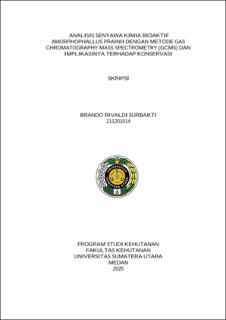Analisis Senyawa Kimia Bioaktif Amorphophallus prainii dengan Metode Gas Chromatography Mass Spectrometry (GCMS) dan Implikasinya Terhadap Konservasi
Analysis of Bioactive Chemical Compounds in Amorphophallus prainii Using Gas Chromatography-Mass Spectrometry (GCMS) and Its Implications for Conservation

Date
2025Author
Surbakti, Brando Rivaldi
Advisor(s)
Rambey, Ridahati
Hakim, Luthfi
Metadata
Show full item recordAbstract
Amorphophallus prainii is a species from the Araceae family that has potential as a source of medicine, food, and animal feed. In North Sumatra, Amorphophallus prainii grows wild in forests as well as in gardens as an understory plant. This research aimed to analyze the chemical compounds contained in the tuber of A. prainii and to evaluate its potential as an ethnomedicinal plant, as well as its role in conservation efforts. The method used was cold-water and hot-water extraction, followed by analysis with Gas Chromatography-Mass Spectrometry (GCMS) to identify the active compounds present in the tuber of A. prainii. The results showed that the tuber of A. prainii contains compounds with medical potential such as pyrrol, pyridinium, tetrydamine, and cyclopentene along with their derivatives, which function as anti-inflammatory, antiseptic, anticancer, antidiabetic, and antimalarial agents. In the chemical industry, these compounds are generally used as intermediates; in agriculture, they are applied as fungicides, herbicides, and insecticides; and in the food industry, they serve as preservatives and flavoring agents. These findings strengthen its potential as an ethnomedicine, thus requiring both in situ and ex situ conservation, and provide a scientific reference for the development, utilization, and preservation of A. prainii.
Collections
- Undergraduate Theses [2162]
